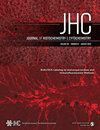“基于照片的图像分析在乳腺癌症激素受体表达定量中的应用”评论。
IF 1.5
4区 生物学
Q4 CELL BIOLOGY
Journal of Histochemistry & Cytochemistry
Pub Date : 2022-11-01
Epub Date: 2022-12-22
DOI:10.1369/00221554221145227
引用次数: 0
摘要
本文章由计算机程序翻译,如有差异,请以英文原文为准。
Commentary on "Application of Photoshop-based Image Analysis to Quantification of Hormone Receptor Expression in Breast Cancer".
At the time of publication of this article, image analysis as applied to diagnostic surgical pathology was a nascent technology, often characterized as a “solution in search of a problem.” After all, biomarkers such as estrogen receptor (ER) in breast cancer were scored in a threshold manner, with the assumption that this scoring was highly accurate and reproducible. Unfortunately, several studies in the early 2000s found significant discordance in this ER evaluation when slides were re-reviewed.1,2 Ironically, prior approaches to determining ER expression in breast cancer, for example, the dextran-coated charcoal method, were quantifiable and reproducible, but required fresh frozen tissue and could not be used on formalin-fixed paraffin-embedded tissue. Image analysis on deparaffinized, formalin-fixed tissue sections immunostained with appropriate antibodies was anticipated to be a method that could increase the predictive power of IHC determination of hormone receptor status. Indeed, this 1997 paper was one of the first to employ image analysis in the evaluation of ER. While after more than two decades Photoshop has maintained its role as a premier raster graphics and digital art editor, it has not taken a second life as an image analysis tool. We selected Photoshop as a “maverick” technique that permitted us to accomplish the analysis we desired, but to also avoid the use of commercial image analysis instruments and software, which at that time were expensive and unaffordable for our laboratory. Today, while commercial image analysis hardware and software are legion, free public domain software such as QuPath can yield comparable results as many commercial software packages3 and far exceed the capabilities of Photoshop. While our 1997 paper succeeded as a “proof of principle,” now 25 years later, ER is still not quantified in the vast majority of cases, but is instead still “eyeballed” to determine whether more than 1% of tumor cells are positive for nuclear signal (or between 1% and 10%), but no image analysis–based quantification is required.4 There may still be a role in the future for more quantitative ER determination in breast cancer, but that will be determined not by technology alone but largely by evidence that may be forthcoming from clinical studies. But it will almost certainly not involve the use of Photoshop!
求助全文
通过发布文献求助,成功后即可免费获取论文全文。
去求助
来源期刊
CiteScore
6.00
自引率
0.00%
发文量
32
审稿时长
1 months
期刊介绍:
Journal of Histochemistry & Cytochemistry (JHC) has been a pre-eminent cell biology journal for over 50 years. Published monthly, JHC offers primary research articles, timely reviews, editorials, and perspectives on the structure and function of cells, tissues, and organs, as well as mechanisms of development, differentiation, and disease. JHC also publishes new developments in microscopy and imaging, especially where imaging techniques complement current genetic, molecular and biochemical investigations of cell and tissue function. JHC offers generous space for articles and recognizing the value of images that reveal molecular, cellular and tissue organization, offers free color to all authors.

 求助内容:
求助内容: 应助结果提醒方式:
应助结果提醒方式:


